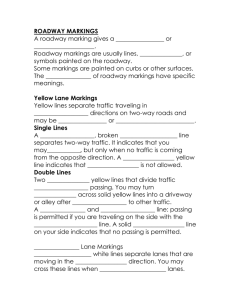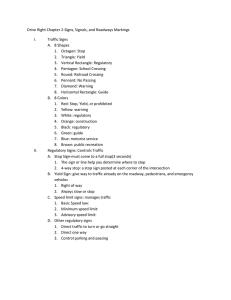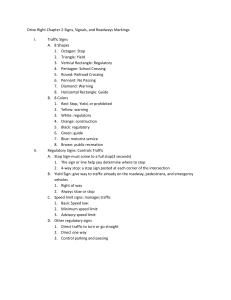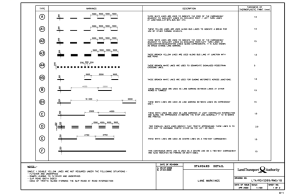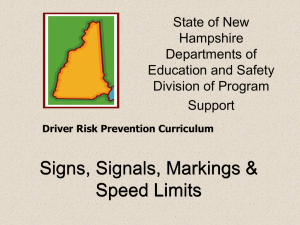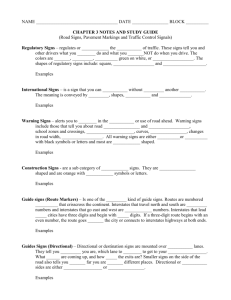File
advertisement
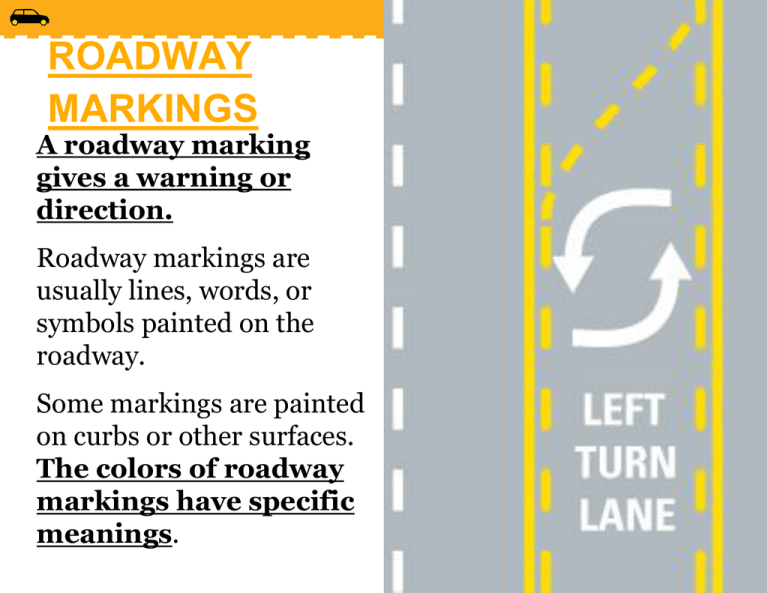
ROADWAY MARKINGS A roadway marking gives a warning or direction. Roadway markings are usually lines, words, or symbols painted on the roadway. Some markings are painted on curbs or other surfaces. The colors of roadway markings have specific meanings. Yellow Lane Markings Yellow lines separate traffic traveling in opposite directions on two-way roads and may be single or double. Single Lines A single, broken yellow line separates two-way traffic. It indicates that you may pass, but only when no traffic is coming from the opposite direction. A solid yellow line indicates that passing is not allowed. A solid and broken line: you must follow the rules and regulations for the line closest to your vehicle. Passing is not allowed if the solid line is nearest your vehicle. Double Lines Two solid yellow lines that divide traffic prohibit passing. You may turn left across solid yellow lines into a driveway or alley after yielding to other traffic. White Lane Markings Broken white lines separate lanes that are moving in the same direction. You may cross these lines when changing lanes. Solid white lines identify locations where changing lanes is hazardous. They keep drivers in their lanes and restrict lane changing. Although it may be legal, you should not cross solid white line markings. Carpool lanes often are indicated by these solid white lines. White arrows in lanes tell you when and where to turn. If you are in a lane with an arrow and the word only, you must continue in the direction of the arrow. You may turn or go straight if there is a curved and straight arrow in your lane. Turning Lanes On busy streets, a shared left-turn lane can help drivers turn left into businesses in the middle of a block. Drivers traveling in either direction may use these lanes. Solid and broken yellow lines with white left-turn arrows pointing in either direction identify a shared left-turn lane. Other Road Markings A number of painted markings are used to warn of possible dangers and restrictions. Stop Lines and Crosswalks School Crossings Railroad Crossings Pedestrian Crossings High-Occupancy Vehicle (HOV) Lanes A large white diamond symbol and black and white rectangular signs identify HOV lanes. HOV lanes may be reserved for highoccupancy motor vehicles. If you travel in these lanes without the minimum number of passengers, you may receive a fine. Highway Exit Ramps A special white marking on the roadway indicates the start of an exit ramp. It is dangerous and illegal to cross this area. Parking Restrictions The meanings of the colors vary from city to city. Red curbs: you cannot stop or park in the area, such as near fire hydrants. White curbs: you may stop for brief periods of time, but may not leave your vehicle. Yellow curbs: loading zones that are reserved for commercial vehicles. Green: Limited time parking Handicapped parking markings are reserved for vehicles with drivers or passengers who are disabled. The curb in these areas may be painted blue. Handicapped spaces are usually larger than regular spaces to allow room for loading a wheelchair into a van. Rumble Strips and Reflective Markers Rumble Strips Short sections of grooved or corrugated roadway are called rumble strips. When you drive over these strips, they cause your car to vibrate and make a loud noise. Rumble strips warn you of an unexpected need to reduce speed or stop, or that you are driving too close to the edge of the road. Speed Bumps Areas such as parking lots and very narrow streets sometimes have raised portions called speed bumps. You should drive no faster than about 5 mph over speed bumps. Driving faster may damage your car. Reflective Markers Some highways are marked with small reflectors that reflect headlight beams. At night and in bad weather, reflective markers are much easier to see than painted markings. In regions where it rarely snows, these markers are raised.
